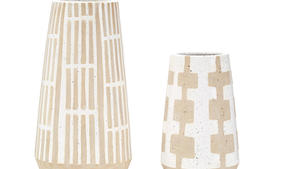Launching a new product concept, the Kasthall design studio debuted Harvest, an environmentally friendly rug collection, at ICFF. The innovative new product range uses leftover spools of yarn from the production process to create modern woven rugs in “color-shifting hues made entirely from residual yarn, each rug with a unique appearance.”

“One of our most important tasks in the design studio is to further Kasthall’s environmental stewardship and minimize our carbon footprint through sustainable design and production methods,” shares Ellinor Eliasson, who created the Harvest concept. “There are often two or three spools of a certain color yarn left over after weaving a rug. This is because we make a few extra spools in case we need to redo something during the production process.”
“We have high-quality requirements for finished products,” she adds, “which is why we cannot reuse the residual spools of wool for rugs in the same collection due to the risk of minor color discrepancies. The variation in color of the residual spools of yarn posed a challenge and inspired us to find an exciting way to put it to use. That’s how the Harvest idea was born.”

Kasthall rugs are made to order and tailored to each customer; it’s a process that allows the brand to avoid stockpiling and to minimize waste. The company’s environmental policy aims to decrease flammable waste in the production process; the yarn is prepared, colored and spooled only for each individual rug. And, in accordance with Kasthall’s 2017 theme, “Arrival of Origin,” the Harvest concept takes its inspiration from the traditional Swedish rag rug.
“Launching the modern rag rug Harvest in New York feels incredibly exciting, since the U.S. market is an important one for Kasthall and we have had an office in New York for the past decade,” says Lena Jiseborn, design director at the Kasthall design studio. “We are proud that this product allows us to showcase how we work with sustainable design and production. Our vision is to be one hundred percent sustainable, and Harvest is an important step toward achieving this.”




























